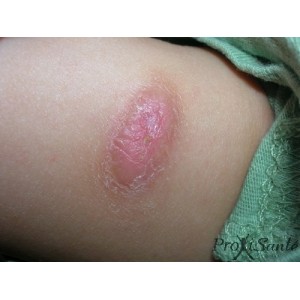An abscess is a collection of pus in the soft tissues. Staphylococcus aureus is the most common causative agent.
Mature abscess appears as a red swelling, inflammatory, painful on palpation generally fluctuating, sometimes fistulized. At this stage, the abscess cavity is inaccessible to antibiotics, the only treatment is surgical.
This collection phase is preceded by a diffusion phase, accessible to medical treatment.
Treatment:
In the diffusion phase:
• Antibiotic therapy:
Children: amoxicillin PO: 80 mg / kg / day divided into 2 or 3 doses
+ Metronidazole PO: 30 to 50 mg / kg / day in 3 divided doses
Adults: amoxicillin PO: 4 g / day in 2 or 3 doses
+ Metronidazole PO: 1.5 g / day in 3 divided doses
or
amoxicillin + clavulanic acid (co-amoxiclav) PO
Children: 80 mg / kg / day in 3 divided doses
Adult: 4 g / day in 3 divided doses
• Adapt analgesics to the pain level (see pain).
• Alcoholic dressing to promote the collection of the abscess compresses soaked in 70% alcohol, 2 times / day (maximum 3 times / day: risk of skin burn).
If improvement after 48 hours: continue antibiotic treatment for 5 days to complete 7 days of treatment.
In the absence of improvement after 48 hours of correct treatment: treat surgically.
A collection phase:
incision of the abscess
Material:
– Handle and sterile scalpel blade
– Curved forceps and without sterile Kelly claw
– Sterile gloves
– Antiseptic
– Syringe of 5 or 10 ml
– Son with nonabsorbable suture
– Sterile wavy blade
Anesthesia abscesses:
With the exception of paronychia, local anesthesia of the abscess is usually impossible. General anesthesia may be indicated with:
IM ketamine 10 mg / kg
Technique:
• Hold the knife between the thumb and middle finger of the dominant hand, index finger pressing on the handle. The other hand holds the abscess between the thumb and forefinger.The cutting edge of the scalpel blade should be perpendicular to the skin.
• The incision is made along the axis of the larger abscess at once franc. Its length should be sufficient to let in a finger.
• Beside a vascular (carotid, axillary, brachial, femoral, popliteal), the incision must be careful.
– Exploration finger (Figure 8b)
• Insert your finger into the cavity to collapse the loculi (a single cavity should remain), evacuate the pus and explore to the edges of the abscess.
• The exploration also allows us to appreciate the deep development of the abscess and its relationship with the noble structures (arterial pulsation) or a possible bone contact. In the latter case a surgical opinion is preferable.
– Washing
Wash the syringe with antiseptic solution.
– Drainage (Figure 8c)
Set up a drainage blade (or alternatively, a gauze wick) into the bottom of the cavity. Attach the blade if possible, with a stitch on one of the banks. The drain is withdrawn progressively and then removed to 3ème- 5th day.
Specific locations:
Breast abscesses (Figures 9a-9d):
– Typically, breast abscess are superficial, they are sometimes deep seat more difficult to diagnose and drain.
In the diffusion phase: medical treatment
– Antibiotic treatment (see above)
– Bandage, stop breastfeeding on the affected side; suction pump.
A collection phase: surgical treatment
– Incision:
• radial for superficial abscesses,
• peri-areolar for abscesses near the areola
• submammary for deep abscesses.
– Gentle exploration with a finger.
– Wash with plenty syringe with antiseptic solution.
– Drainage off by a wavy blade.
Parotid abscess:
The incision of the abscess may damage the facial nerve. Therefore, incision horizontally to the lower part of the collection.





You must be logged in to post a comment.